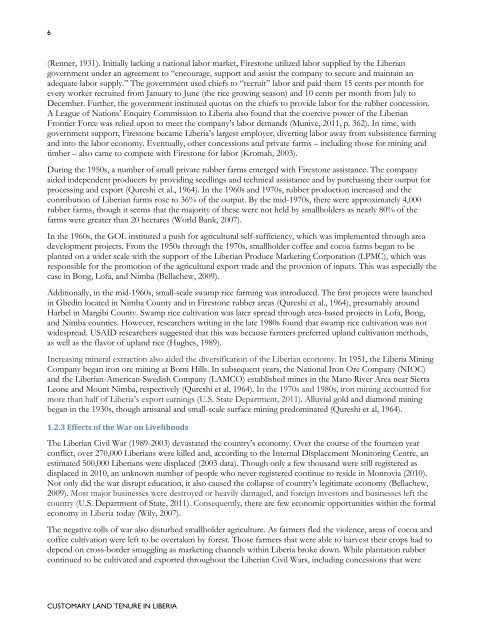Customary Land Tenure in Liberia - Land Tenure and Property ...
Customary Land Tenure in Liberia - Land Tenure and Property ...
Customary Land Tenure in Liberia - Land Tenure and Property ...
You also want an ePaper? Increase the reach of your titles
YUMPU automatically turns print PDFs into web optimized ePapers that Google loves.
6<br />
(Renner, 1931). Initially lack<strong>in</strong>g a national labor market, Firestone utilized labor supplied by the <strong>Liberia</strong>n<br />
government under an agreement to “encourage, support <strong>and</strong> assist the company to secure <strong>and</strong> ma<strong>in</strong>ta<strong>in</strong> an<br />
adequate labor supply.” The government used chiefs to “recruit” labor <strong>and</strong> paid them 15 cents per month for<br />
every worker recruited from January to June (the rice grow<strong>in</strong>g season) <strong>and</strong> 10 cents per month from July to<br />
December. Further, the government <strong>in</strong>stituted quotas on the chiefs to provide labor for the rubber concession.<br />
A League of Nations‟ Enquiry Commission to <strong>Liberia</strong> also found that the coercive power of the <strong>Liberia</strong>n<br />
Frontier Force was relied upon to meet the company‟s labor dem<strong>and</strong>s (Munive, 2011, p. 362). In time, with<br />
government support, Firestone became <strong>Liberia</strong>‟s largest employer, divert<strong>in</strong>g labor away from subsistence farm<strong>in</strong>g<br />
<strong>and</strong> <strong>in</strong>to the labor economy. Eventually, other concessions <strong>and</strong> private farms – <strong>in</strong>clud<strong>in</strong>g those for m<strong>in</strong><strong>in</strong>g <strong>and</strong><br />
timber – also came to compete with Firestone for labor (Kromah, 2003).<br />
Dur<strong>in</strong>g the 1950s, a number of small private rubber farms emerged with Firestone assistance. The company<br />
aided <strong>in</strong>dependent producers by provid<strong>in</strong>g seedl<strong>in</strong>gs <strong>and</strong> technical assistance <strong>and</strong> by purchas<strong>in</strong>g their output for<br />
process<strong>in</strong>g <strong>and</strong> export (Qureshi et al., 1964). In the 1960s <strong>and</strong> 1970s, rubber production <strong>in</strong>creased <strong>and</strong> the<br />
contribution of <strong>Liberia</strong>n farms rose to 36% of the output. By the mid-1970s, there were approximately 4,000<br />
rubber farms, though it seems that the majority of these were not held by smallholders as nearly 80% of the<br />
farms were greater than 20 hectares (World Bank, 2007).<br />
In the 1960s, the GOL <strong>in</strong>stituted a push for agricultural self-sufficiency, which was implemented through area<br />
development projects. From the 1950s through the 1970s, smallholder coffee <strong>and</strong> cocoa farms began to be<br />
planted on a wider scale with the support of the <strong>Liberia</strong>n Produce Market<strong>in</strong>g Corporation (LPMC), which was<br />
responsible for the promotion of the agricultural export trade <strong>and</strong> the provision of <strong>in</strong>puts. This was especially the<br />
case <strong>in</strong> Bong, Lofa, <strong>and</strong> Nimba (Bellachew, 2009).<br />
Additionally, <strong>in</strong> the mid-1960s, small-scale swamp rice farm<strong>in</strong>g was <strong>in</strong>troduced. The first projects were launched<br />
<strong>in</strong> Gbed<strong>in</strong> located <strong>in</strong> Nimba County <strong>and</strong> <strong>in</strong> Firestone rubber areas (Qureshi et al., 1964), presumably around<br />
Harbel <strong>in</strong> Margibi County. Swamp rice cultivation was later spread through area-based projects <strong>in</strong> Lofa, Bong,<br />
<strong>and</strong> Nimba counties. However, researchers writ<strong>in</strong>g <strong>in</strong> the late 1980s found that swamp rice cultivation was not<br />
widespread. USAID researchers suggested that this was because farmers preferred upl<strong>and</strong> cultivation methods,<br />
as well as the flavor of upl<strong>and</strong> rice (Hughes, 1989).<br />
Increas<strong>in</strong>g m<strong>in</strong>eral extraction also aided the diversification of the <strong>Liberia</strong>n economy. In 1951, the <strong>Liberia</strong> M<strong>in</strong><strong>in</strong>g<br />
Company began iron ore m<strong>in</strong><strong>in</strong>g at Bomi Hills. In subsequent years, the National Iron Ore Company (NIOC)<br />
<strong>and</strong> the <strong>Liberia</strong>n-American-Swedish Company (LAMCO) established m<strong>in</strong>es <strong>in</strong> the Mano River Area near Sierra<br />
Leone <strong>and</strong> Mount Nimba, respectively (Qureshi et al, 1964). In the 1970s <strong>and</strong> 1980s, iron m<strong>in</strong><strong>in</strong>g accounted for<br />
more than half of <strong>Liberia</strong>‟s export earn<strong>in</strong>gs (U.S. State Department, 2011). Alluvial gold <strong>and</strong> diamond m<strong>in</strong><strong>in</strong>g<br />
began <strong>in</strong> the 1930s, though artisanal <strong>and</strong> small-scale surface m<strong>in</strong><strong>in</strong>g predom<strong>in</strong>ated (Qureshi et al, 1964).<br />
1.2.3 Effects of the War on Livelihoods<br />
The <strong>Liberia</strong>n Civil War (1989-2003) devastated the country‟s economy. Over the course of the fourteen year<br />
conflict, over 270,000 <strong>Liberia</strong>ns were killed <strong>and</strong>, accord<strong>in</strong>g to the Internal Displacement Monitor<strong>in</strong>g Centre, an<br />
estimated 500,000 <strong>Liberia</strong>ns were displaced (2003 data). Though only a few thous<strong>and</strong> were still registered as<br />
displaced <strong>in</strong> 2010, an unknown number of people who never registered cont<strong>in</strong>ue to reside <strong>in</strong> Monrovia (2010).<br />
Not only did the war disrupt education, it also caused the collapse of country‟s legitimate economy (Bellachew,<br />
2009). Most major bus<strong>in</strong>esses were destroyed or heavily damaged, <strong>and</strong> foreign <strong>in</strong>vestors <strong>and</strong> bus<strong>in</strong>esses left the<br />
country (U.S. Department of State, 2011). Consequently, there are few economic opportunities with<strong>in</strong> the formal<br />
economy <strong>in</strong> <strong>Liberia</strong> today (Wily, 2007).<br />
The negative tolls of war also disturbed smallholder agriculture. As farmers fled the violence, areas of cocoa <strong>and</strong><br />
coffee cultivation were left to be overtaken by forest. Those farmers that were able to harvest their crops had to<br />
depend on cross-border smuggl<strong>in</strong>g as market<strong>in</strong>g channels with<strong>in</strong> <strong>Liberia</strong> broke down. While plantation rubber<br />
cont<strong>in</strong>ued to be cultivated <strong>and</strong> exported throughout the <strong>Liberia</strong>n Civil Wars, <strong>in</strong>clud<strong>in</strong>g concessions that were<br />
CUSTOMARY LAND TENURE IN LIBERIA

















